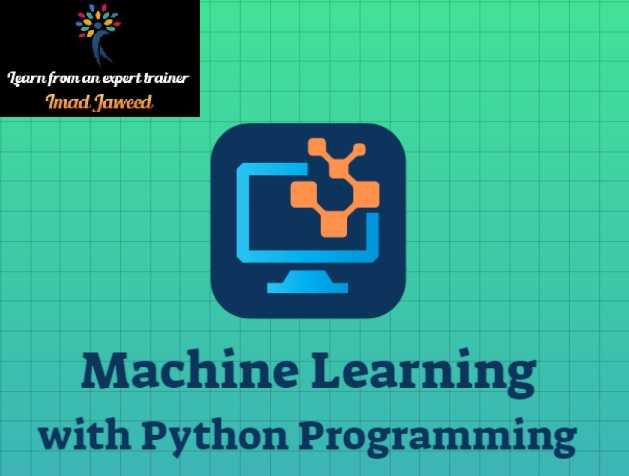Machine Learning with Python Programming

Machine Learning with Python Programming
Machine Learning with Python Programming- syllabus
Python Programming (Part-1)
Introduction to Python Programming
What is Python Programming?
History of Python Programming
Features of Python Programming
Why to learn Python Programming
Application of Python Programming
Setup of Python Programming
Getting Python
Installation of Python
Getting started with the first Python program
Running the first Python Program
Variables and Data types
What is a variable?
Declaration of variable
Variable assignment
Data types in Python
Checking Data type
Data types Conversion
Python programs for Variables and Data types.
Python Identifiers, Keywords, Reading Input, Output Formatting
What is an Identifier?
Keywords
Reading Input
Taking multiple inputs from user
Output Formatting
Python end parameter
Operators in Python
Operators and types of operators
1. Arithmetic Operators
2. Relational Operators
3. Assignment Operators
4. Logical Operators
5. Membership Operators
6. Identity Operators
7. Bitwise Operators
Python programs for all types of operators
DECISION MAKING
Introduction to Decision making
Types of decision making statements
Introduction, syntax, flowchart and programs for
- if statement
- if…else statement
- elif statement
Loops
Introduction to loops
Types of loops
- for loop
- while loop
- infinite loop
- nested loop
Break, continue and pass statement
Python programs for all types of loops
NUMBERS
Number Type Conversion
Random Number Functions
Trigonometric Functions
Mathematical Constants
STRINGS
Accessing Values in Strings
Updating Strings
String Special Operators
Built-in String Methods
LISTS
Python Lists
Accessing Values in Lists
Updating Lists
Deleting List Elements
Basic List Operations
Built-in List Functions and Methods
TUPLES
Accessing Values in Tuples
Updating Tuples
Deleting Tuple Elements
Basic Tuples Operations
Built-in Tuple Functions
Difference between list and tuple
DICTIONARY
Accessing Values in Dictionary
Updating Dictionary
Delete Dictionary Elements
Properties of Dictionary Keys
Built-in Dictionary Functions and Methods
FUNCTIONS
Defining a Function
Calling a Function
Passing by Reference versus Passing by Value
Ways to write function
Types of functions
Anonymous function
Recursive Function
MODULES
What is a module?
Creating a module
The import Statement
The ‘from’ import Statement
Renaming a module
Using the dir() function
The ‘from’ import * Statement
Locating Modules
FILES I/O
Printing to the Screen
Opening and Closing Files
The open Function
The file Object Attributes
The close() Method
Reading and Writing Files
The write() Method
The read() Method
MORE OPERATIONS ON FILES
REGULAR EXPRESSION
What is a REGULAR EXPRESSION?
Metacharacters
match() function
search() function
re.match() vs re.search()
findall() function
split() function
sub() function
Machine Learning (Part-2)
Introduction to Machine Learning
What is a Machine Learning?
Need for Machine Learning
Why & When to Make Machines Learn?
Challenges in Machines Learning
Application of Machine Learning
Types of Machine Learning
Types of Machine Learning
• Supervised learning
• Unsupervised learning
• Reinforcement learning
Difference between Supervised and Unsupervised learning
• Summary
Components of Python ML Ecosystem
Using Pre-packaged Python Distribution: Anaconda
Jupyter Notebook
NumPy
Pandas
Scikit-learn
Regression Analysis (Part-I)
Regression Analysis
Linear Regression
Examples on Linear Regression
scikit-learn library to implement simple linear regression
Regression Analysis (Part-II)
Multiple Linear Regression
Examples on Multiple Linear Regression
Polynomial Regression
Examples on Polynomial Regression
Classification (Part-I)
What is Classification
Classification Terminologies in Machine Learning
Types of Learner in Classification
Logistic Regression
Example on Logistic Regression
Classification (Part-II)
What is KNN?
How does the KNN algorithm work?
How do you decide the number of neighbors in KNN?
Implementation of KNN classifier
What is a Decision Tree?
Implementation of Decision Tree
SVM and its implementation
Clustering (Part-I)
What is Clustering?
Applications of Clustering
Clustering Algorithms
K-Means Clustering
How does K-Means Clustering work?
K-Means Clustering algorithm example
Clustering (Part-II)
Hierarchical Clustering
Agglomerative Hierarchical clustering and how does it work
Woking of Dendrogram in Hierarchical clustering
Implementation of Agglomerative Hierarchical Clustering
Association Rule Learning
Association Rule Learning
Apriori algorithm
Working of Apriori algorithm
Implementation of Apriori algorithm
Recommender Systems
Introduction to Recommender Systems
Content-based Filtering
How Content-based Filtering work
Collaborative Filtering
Implementation of Movie Recommender System
After the completion of this course, you will get the certification.
The market for Artificial Intelligence and Machine Learning is extremely hot right now. The demand for talented and skilled professionals in Machine Learning is at its peak now, and in the future, it will only escalate higher. The great thing about a Machine Learning career is that apart from job satisfaction and security, it also promises hefty annual compensation and fast career growth. All the more reason to consider building a Machine Learning career path.
2. Data Scientist
3. Software Developer/Engineer (AI/ML)
4. Human-Centered Machine Learning Designer
According to a 2019 Indeed report, Machine Learning Engineer is the #1 job in the list of The Best Jobs in the US, recording a whopping 344% growth with a median salary of $146,085 per year. In India, the national average salary for Machine Learning jobs is ₹11,05,748.








